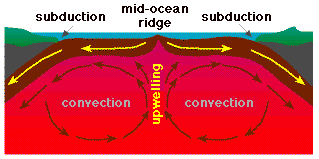
The structure of the ocean floor is closely related to tectonic movement of the earth's crust. These aspects can only be dicussed very briefly in the context of an oceanography laboratory.
The earth's crust is made up of a number of plates that float on the fluid interior. Convection in the earth's mantle makes material rise ("upwell") at certain places. The upwelling pushes the ocean floor up, creating the mid-ocen ridges. Material brought up from the mantle moves away from the mid-ocean ridges; this divergent movement creates the rift valley.
Some plates consist of ocean floor and continental land mass, which move together. The continent floats on the mantle like an iceberg on water, pushing the crust down under its own weight. This produces the continental shelf regions, which are submerged parts of the continents. Mountain chains, such as the Himalayas, are folded upward where plates collide.
Some plate boundaries coincide with the boundary between ocean and continents. Where this is the case, the oceanic plate is pressed under the continental plate (subducted). This forms a deep ocean trench in the sea and a mountain chain on land. An example are the Andes in South America with the associated Atacama and Peru trench system.
At certain locations material is pushed upward from the earth's mantle, penetrating the crust and forming a volcano. These locations are stationary in the mantle and known as hot spots; the crustal plates drift over them. As a result, the location where the material penetrates the crust changes with time. This produces a series of seamounts or islands along the line where the crust moves across the hot spot. Two examples are the Hawaiian Islands and the Society Islands (Tahiti). Both are located on the Pacific plate which moves in a northwestward direction. The present location of the hot spot is therefore under the most southeastern island. Islands with extinct volcanoes representing previous hot spot locations stretch in a northwestward direction like beads on a chain. The Canary Islands are an example of hot spot activity in the Atlantic Ocean.